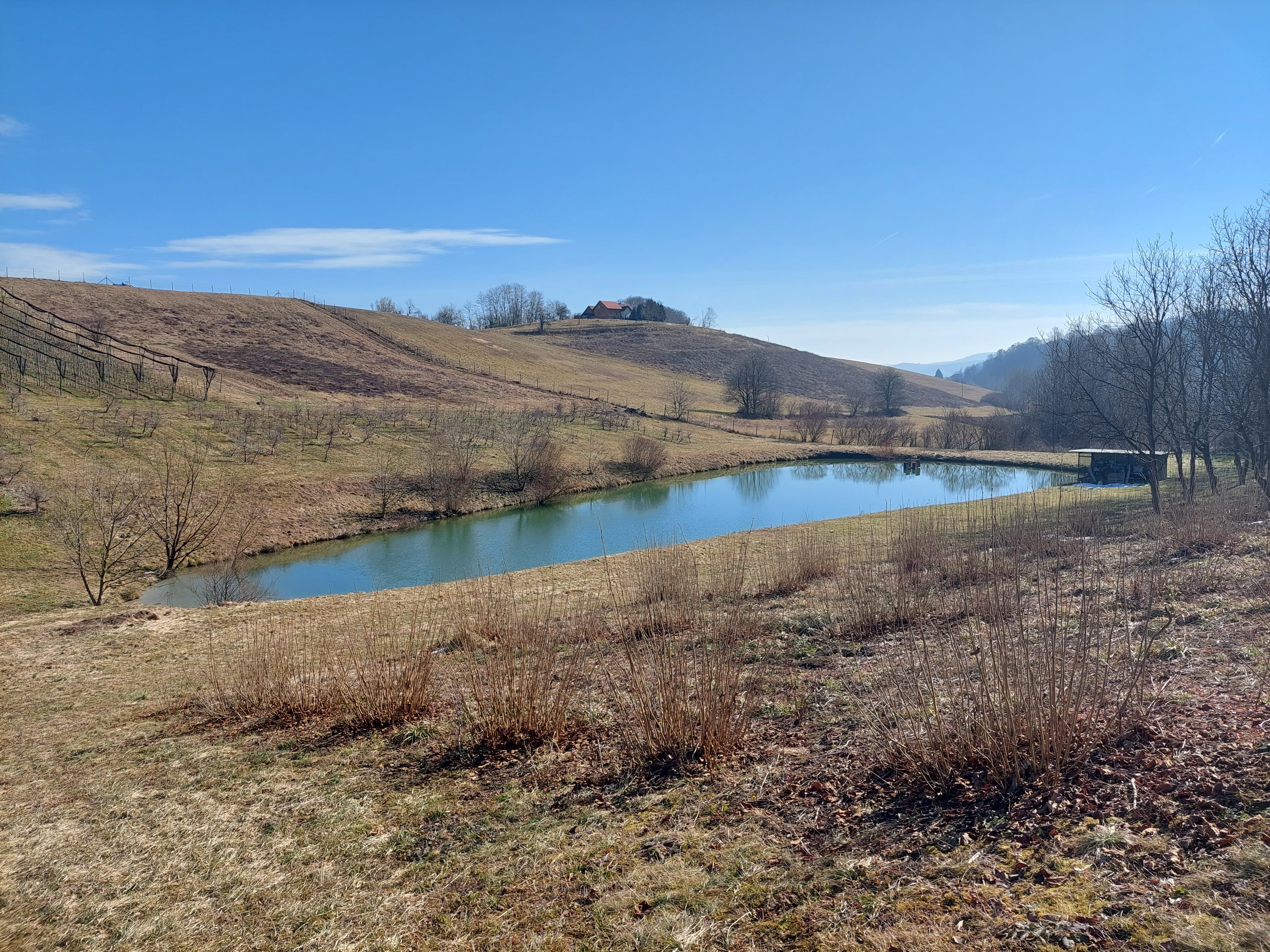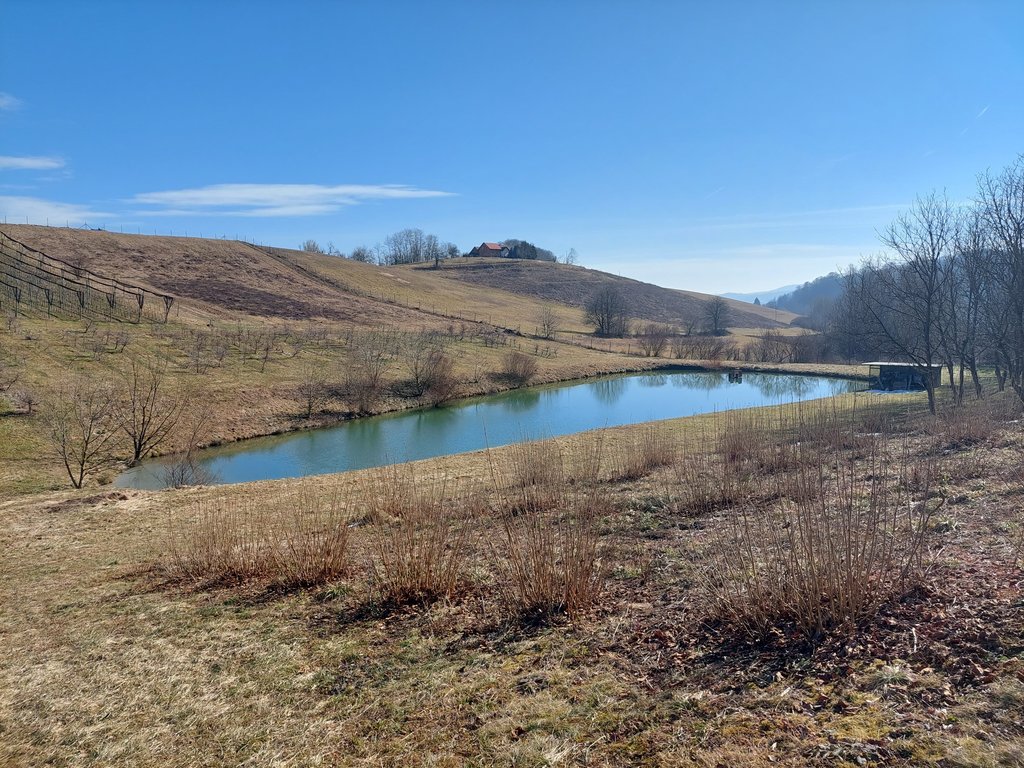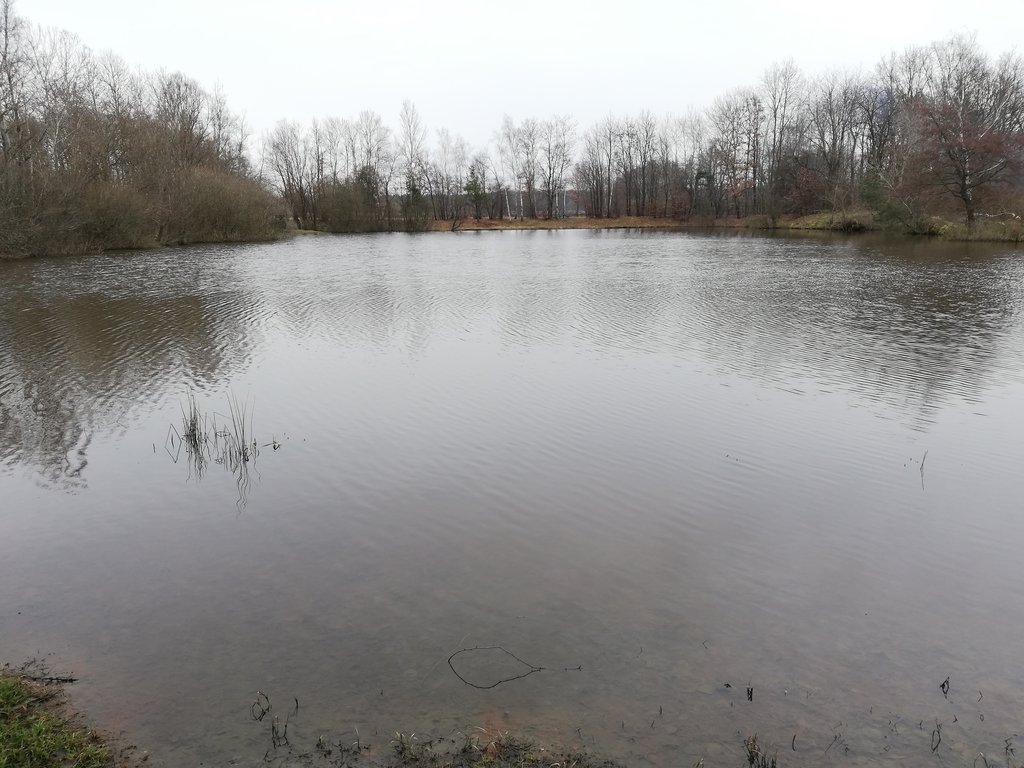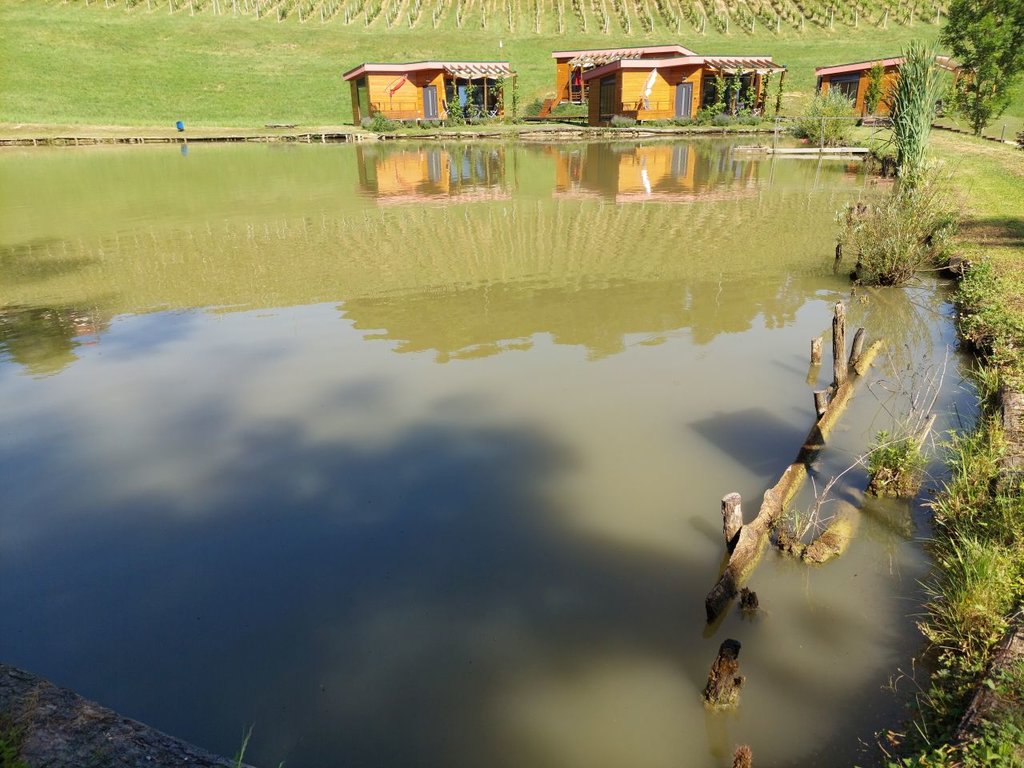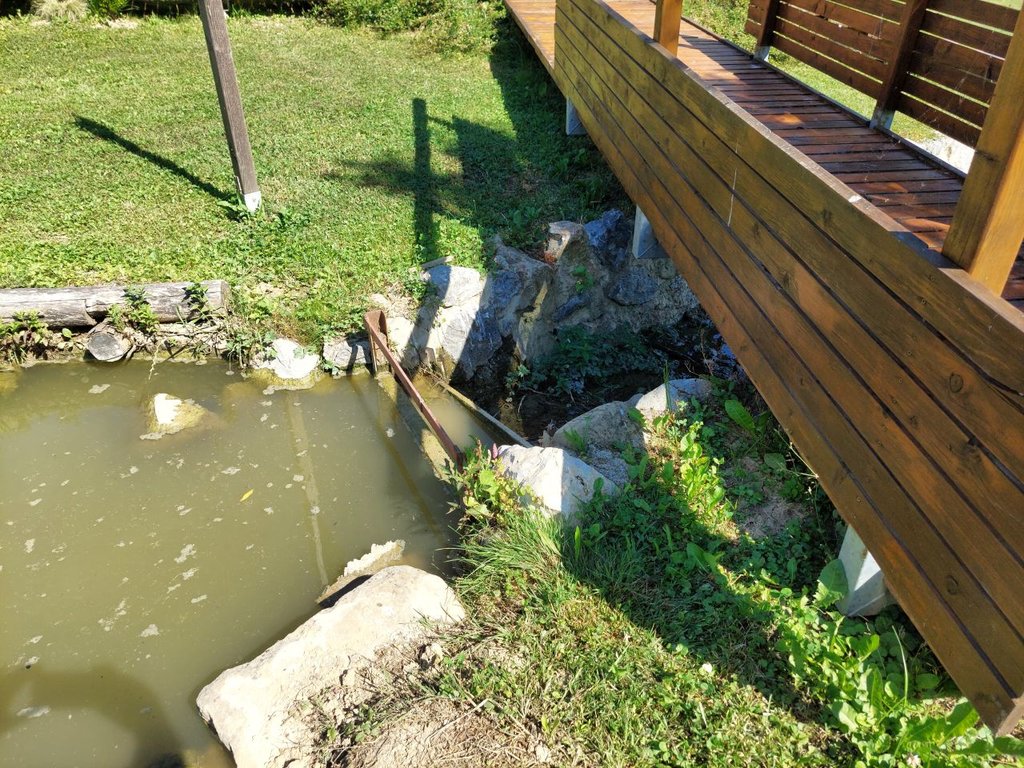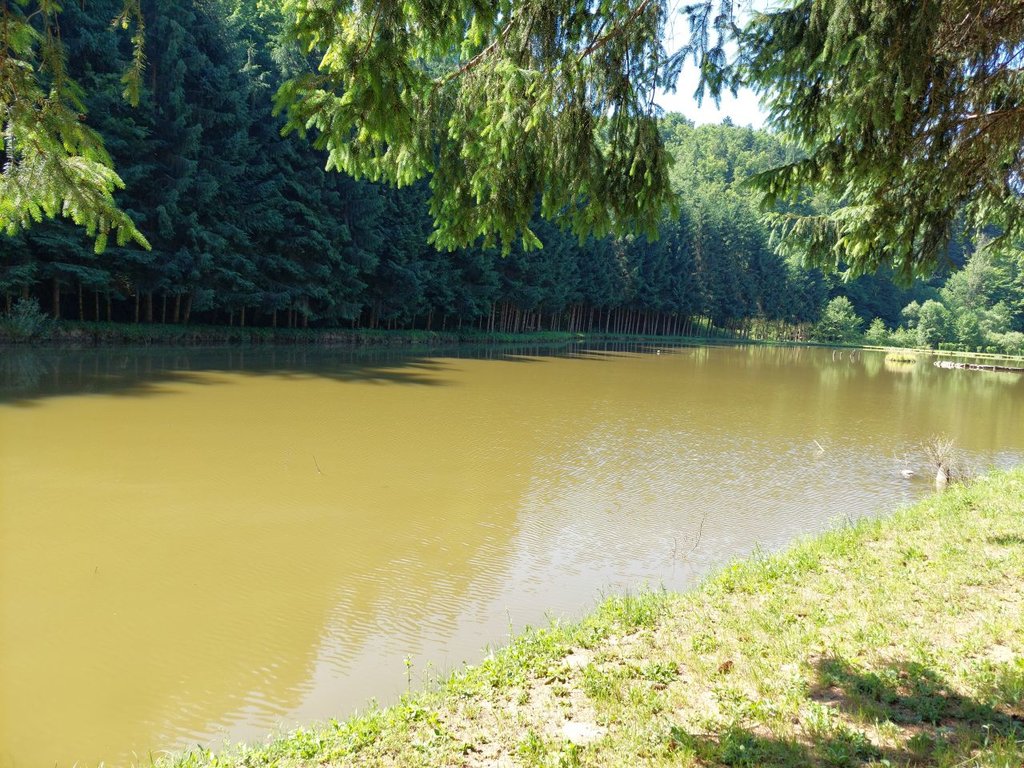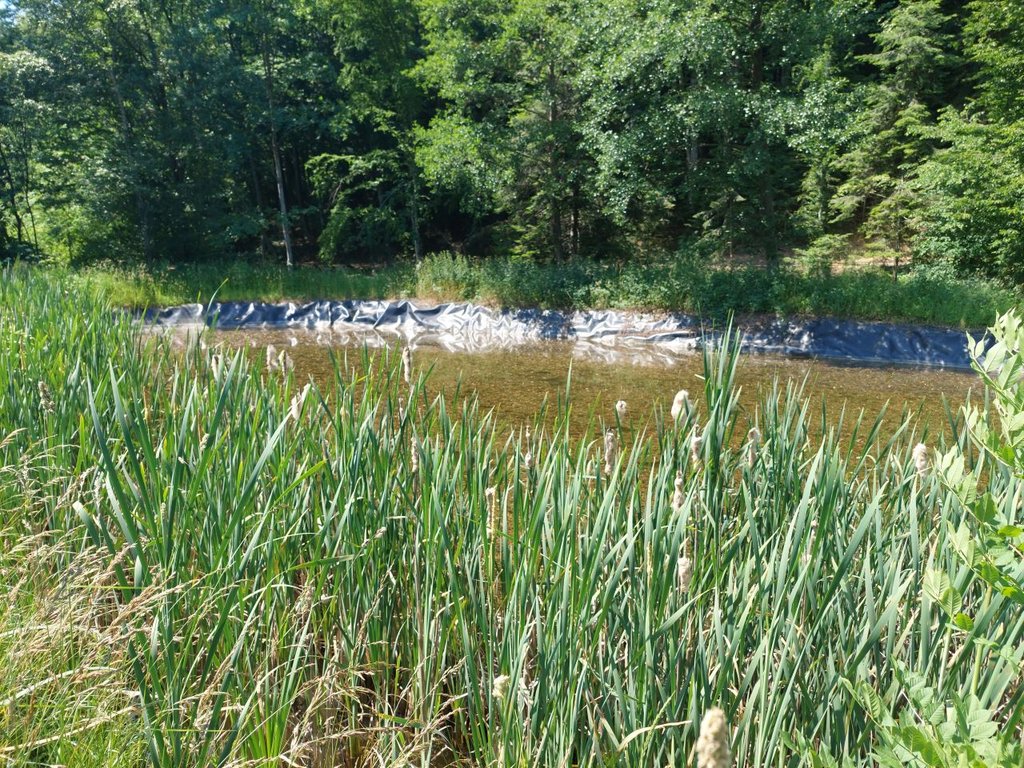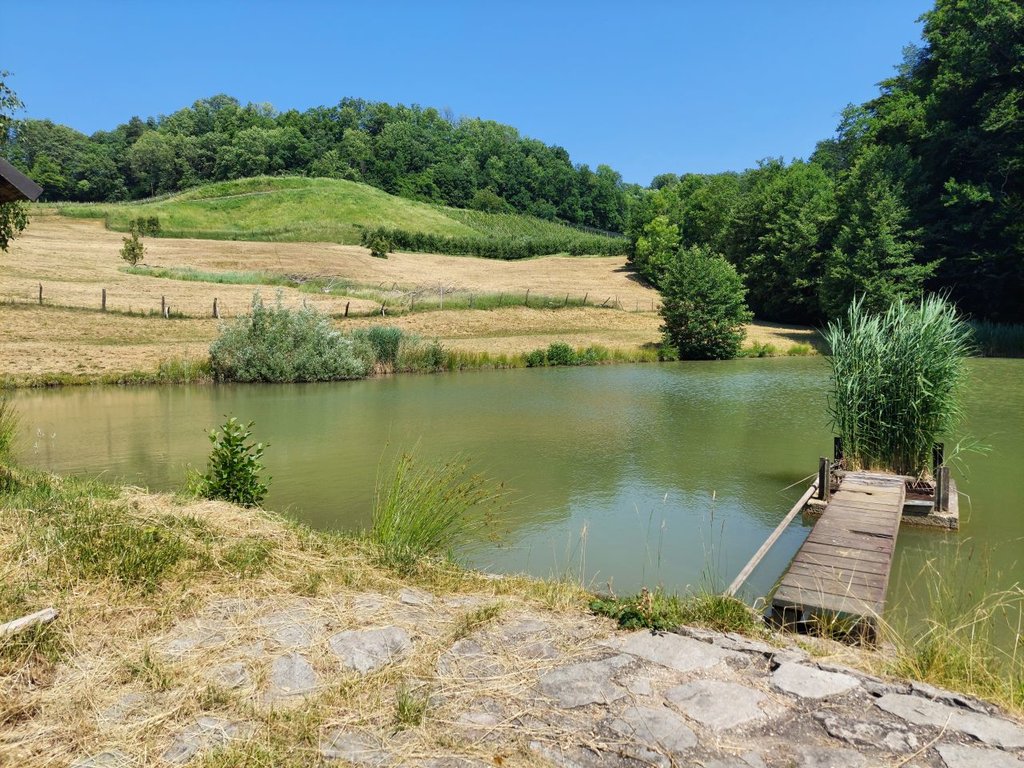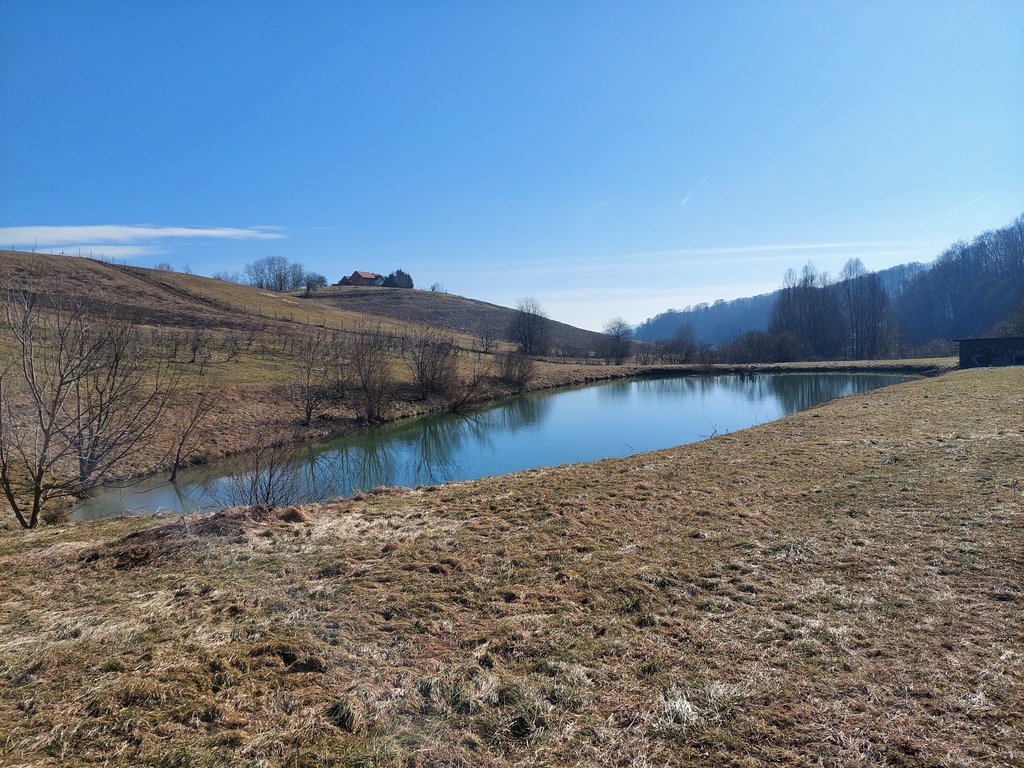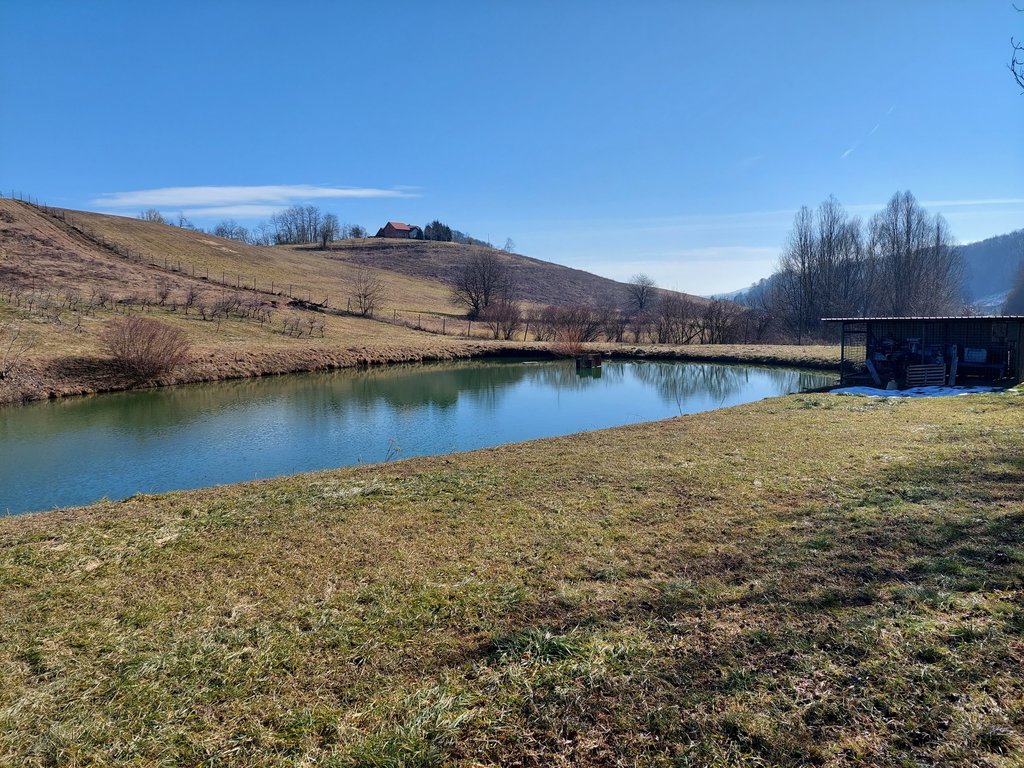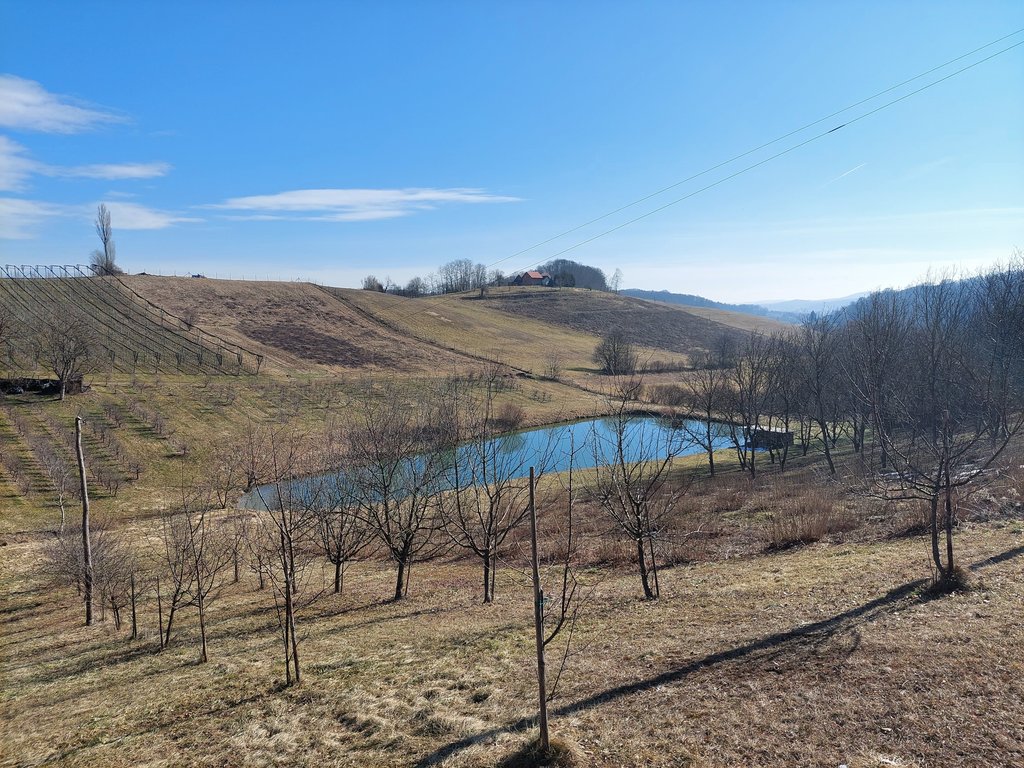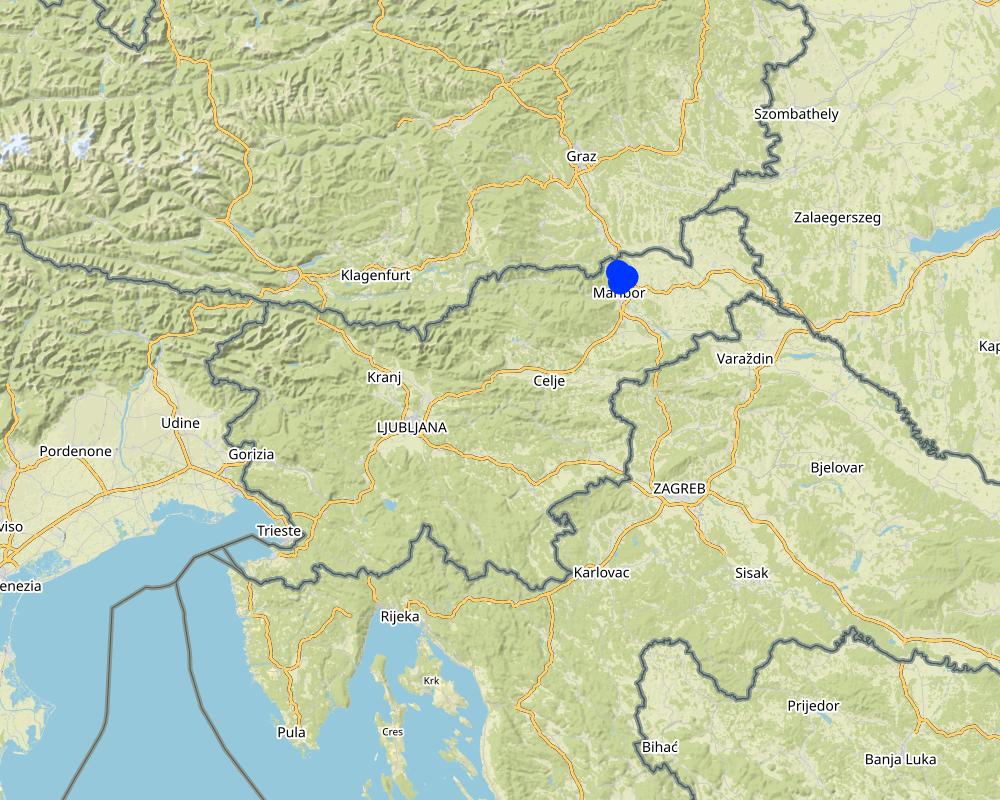Retention ponds [ប្រទេសស្លូវេនី]
- ការបង្កើត៖
- បច្ចុប្បន្នភាព
- អ្នកចងក្រង៖ Gregor Kramberger
- អ្នកកែសម្រួល៖ –
- អ្នកត្រួតពិនិត្យច្រើនទៀត៖ William Critchley, Rima Mekdaschi Studer
Mokri zadrževalniki vode
technologies_5933 - ប្រទេសស្លូវេនី
ពិនិត្យមើលគ្រប់ផ្នែក
ពង្រីកមើលទាំងអស់ បង្រួមទាំងអស់1. ព័ត៌មានទូទៅ
1.2 ព័ត៌មានលម្អិតពីបុគ្គលសំខាន់ៗ និងស្ថាប័នដែលចូលរួមក្នុងការវាយតម្លៃ និងចងក្រងឯកសារនៃបច្ចេកទេស
អ្នកជំនាញឯកទេស SLM:
អ្នកជំនាញឯកទេស SLM:
Istenič Darja
Faculty of Civil and Geodetic Engineering, University of Ljubljana
ប្រទេសស្លូវេនី
អ្នកជំនាញឯកទេស SLM:
Škerjanec Mateja
Faculty of Civil and Geodetic Engineering, University of Ljubljana
ប្រទេសស្លូវេនី
អ្នកជំនាញឯកទេស SLM:
Banovec Primož
Faculty of Civil and Geodetic Engineering, University of Ljubljana
ប្រទេសស្លូវេនី
អ្នកជំនាញឯកទេស SLM:
Curk Miha
Biotechnical Faculty, University of Ljubljana
ប្រទេសស្លូវេនី
អ្នកជំនាញឯកទេស SLM:
Cvejić Rozalija
Biotechnical Faculty, University of Ljubljana
ប្រទេសស្លូវេនី
អ្នកប្រើប្រាស់ដី:
Purgaj Donik Biserka
Fruit center Maribor (demonstrartion plantation centre), Institute of Agriculture and Forestry Maribor
ប្រទេសស្លូវេនី
ឈ្មោះគម្រោងដែលបានចងក្រងឯកសារ/ វាយតម្លៃលើបច្ចេកទេស (បើទាក់ទង)
OPtimal strategies to retAIN and re-use water and nutrients in small agricultural catchments across different soil-climatic regions in Europe (OPTAIN)ឈ្មោះអង្គភាពមួយ (ច្រើន) ដែលបានចងក្រងឯកសារ/ វាយតម្លៃបច្ចេកទេស (បើទាក់ទង)
Chamber of Agriculture and Forestry of Slovenia – Institute of Agriculture and Forestry Maribor (KGZS) - ប្រទេសស្លូវេនីឈ្មោះអង្គភាពមួយ (ច្រើន) ដែលបានចងក្រងឯកសារ/ វាយតម្លៃបច្ចេកទេស (បើទាក់ទង)
University of Ljubljana (UL) - ប្រទេសស្លូវេនី1.3 លក្ខខណ្ឌទាក់ទងទៅនឹងការប្រើប្រាស់ទិន្នន័យដែលបានចងក្រងតាមរយៈ វ៉ូខេត
អ្នកចងក្រង និង(បុគ្គលសំខាន់ៗ)យល់ព្រមទទួលយកនូវលក្ខខណ្ឌនានាទាក់ទងទៅនឹងការប្រើប្រាស់ទិន្នន័យដែលបានចងក្រងតាមរយៈវ៉ូខេត:
បាទ/ចា៎
1.4 សេចក្តីប្រកាសស្តីពីចីរភាពនៃការពណ៌នាពីបច្ចេកទេស
តើបច្ចេកទេសដែលបានពណ៌នានេះមានបញ្ហាដែលផ្តោតលើការធ្លាក់ចុះគុណភាពដី, បើដូច្នេះវាមិនអាចត្រូវបានប្រកាសថាជាបច្ចេកទេសនៃការគ្រប់គ្រងប្រកបដោយចីរភាពទេ?
ទេ
មតិយោបល់:
With improper implementation and intended use, it can have a negative effect on sustainability in the environment. It can be sustainable if properly anticipated/planned. The construction of the pond is usually subject to an environmental impact assessment where these matters are resolved as to whether it is sustainable or not.
2. ការពណ៌នាពីបច្ចេកទេស SLM
2.1 ការពណ៌នាដោយសង្ខេបពីបច្ចេកទេស
និយមន័យបច្ចេកទេស:
Retention ponds (e.g. flood storage reservoirs, shallow impoundments) are water bodies, storing water to attenuate surface runoff during rainfall events. They provide storage as well as improving water quality. Retention ponds may also be used for irrigation of farmland.
2.2 ការពណ៌នាលម្អិតពីបច្ចេកទេស
ការពណ៌នា:
“Retention ponds” comprise both simple, small ponds (up to 2000 m3, up to 4 m deep) and larger, more complex reservoirs (greater than 2000 m3). Retention ponds are designed to provide storage capacity to attenuate surface runoff during rainfall events. Each consists of a permanent ponded area with landscaped banks. Retention ponds achieve both storm water attenuation and water quality treatment through supplementary storage capacity of runoff. Water is then released at a controlled rate once the risk of flooding has passed. The technology can be applied in a natural or human environment. Before construction of a pond it is essential to follow legislation, which covers conditions and restrictions for the given location. Once a site is selected, technical documentation is prepared: first the conceptual design, then documentation for obtaining opinion, consent and a building permit. Later there is also project documentation for implementation. If the water is to be used for other purposes as well (e.g. for irrigation), it is necessary to plan for usage and environmental impact. Retention and still water promotes pollutant removal through sedimentation, while aquatic vegetation and biological uptake mechanisms offer additional treatment. Retention ponds are effective in removing urban pollutants and improving water quality.
They are created either by using an existing natural depression, or by excavating a new depression, or by constructing embankments. Existing natural water bodies should not be used however, due to the risk that pollution events and poorer water quality might disturb/damage the natural ecology of the system. A great benefit of retention ponds is that they hold water when there is an excess of it, which can be used later when water is not available (e.g. for irrigation). Irrigation users are farmers, so they see the advantage of using a retention system. In addition to irrigation, water has also been needed in recent years for anti-frost systems (sprinkling a consistent layer of water on the crop during an entire frost event until temperatures are back to safe levels). Disadvantages are mainly restrictions in some areas (e.g. protected areas), preparation of demanding documentation and bureaucracy, and lengthy procedures for obtaining permits.
2.3 រូបភាពនៃបច្ចេកទេស
2.5 ប្រទេស/តំបន់/ទីតាំងកន្លែង ដែលបច្ចេកទេសត្រូវបានអនុវត្ត និងបានគ្រប់ដណ្តប់ដោយការវាយតម្លៃនេះ
ប្រទេស:
ប្រទេសស្លូវេនី
តំបន់/រដ្ឋ/ខេត្ត:
Podravska region, Slovenia
បញ្ជាក់បន្ថែមពីលក្ខណៈនៃទីតាំង:
Pesnica
បញ្ជាក់ពីការសាយភាយនៃបច្ចេកទេស:
- អនុវត្តនៅកន្លែងជាក់លាក់មួយ/ ប្រមូលផ្តុំនៅតំបន់តូចៗ
តើបច្ចេកទេស (មួយ ឬច្រើន) ទាំងនោះស្ថិតនៅក្នុងតំបន់ការពារជាអចិន្ត្រៃយ៍ណាមួយដែរឬទេ?
ទេ
មតិយោបល់:
Setting up a measure in a protected area is limited and very difficult due to construction restrictions in such an environment.
Map
×2.6 កាលបរិច្ឆេទនៃការអនុវត្ត
ប្រសិនបើមិនច្បាស់ឆ្នាំ សូមបញ្ជាក់កាលបរិច្ឆេទដែលប្រហាក់ប្រហែល:
- 10-50 ឆ្នាំ
2.7 ការណែនាំពីបច្ចេកទេស
សូមបញ្ជាក់តើបច្ចេកទេសត្រូវបានណែនាំឱ្យអនុវត្តដោយរបៀបណា:
- ជាផ្នែកនៃប្រព័ន្ធប្រពៃណី (> 50 ឆ្នាំ)
- តាមរយៈគម្រោង / អន្តរាគមន៍ពីខាងក្រៅ
មតិយោបល់ (ប្រភេទនៃគម្រោង ។ល។):
In the 1990s, the state financed the construction of several water reservoirs in the area.
3. ចំណាត់ថ្នាក់នៃបច្ចេកទេស SLM
3.1 គោលបំណងចម្បង (១ ឬច្រើន) នៃបច្ចេកទេសនេះ
- ធ្វើឱ្យប្រសើរឡើងនូវផលិតកម្ម
- ការពារតំបន់ទីជម្រាល/តំបន់ខ្សែទឹកខាងក្រោមបញ្ចូលជាមួយបច្ចេកទេសផ្សេងទៀត
- កាត់បន្ថយហានិភ័យនៃគ្រោះមហន្តរាយ
- បន្ស៊ាំទៅនឹងការប្រែប្រួលអាកាសធាតុ/គ្រោះមហន្តរាយ និងផលប៉ះពាល់របស់វា
- បង្កើតផលប្រយោជន៍សេដ្ឋកិច្ច
3.2 ប្រភេទដីប្រើប្រាស់មួយប្រភេទ (ច្រើនប្រភេទ) ដែលបានអនុវត្តបច្ចេកទេស
ដីប្រើប្រាស់ចម្រុះនៅលើដីតែមួយ:
ទេ

ផ្លូវទឹក ផ្ទៃទឹក ដីសើម
- ស្រះ ទំនប់
ផលិតផល/សេវាកម្មចម្បង:
Retention of water, collection of water. Retention ponds are ponds or basins designed with additional storage capacity to attenuate surface runoff during rainfall events. In dry years, the water can be used for agriculture, e.g. for irrigation.
3.3 បន្ទាប់ពីអនុវត្តបច្ចេកទេស តើដីប្រើប្រាស់មានការប្រែប្រួលដែររឺទេ?
បន្ទាប់ពីអនុវត្តបច្ចេកទេស តើដីប្រើប្រាស់មានការប្រែប្រួលដែររឺទេ?
- បាទ/ច៎ា (សូមបំពេញសំណួរខាងក្រោមពីស្ថានភាពដីប្រើប្រាស់មុនពេលអនុវត្តបច្ចេកទេស)
ដីប្រើប្រាស់ចម្រុះនៅលើដីតែមួយ:
ទេ

ផ្លូវទឹក ផ្ទៃទឹក ដីសើម
- ខ្សែទឹក ផ្លូវទឹក
- វាលភក់ ដីសើម
3.4 ការផ្គត់ផ្គង់ទឹក
ការផ្គត់ផ្គង់ទឹកនៅកន្លែងអនុវត្តបច្ចេកទេស:
- ទឹកភ្លៀង
3.5 ក្រុម SLM ដែលបច្ចេកទេសស្ថិតនៅក្នុង
- ការស្តុកទុកទឹក
- ការគ្រប់គ្រងប្រព័ន្ធស្រោចស្រព (រួមទាំងការផ្គត់ផ្គង់ទឹក ប្រព័ន្ធបង្ហូរ)
- ការគ្រប់គ្រងទឹកលើដី (ទឹកធ្លាក់ ទន្លេ បឹង សមុទ្រ)
3.6 វិធានការ SLM ដែលបញ្ចូលនូវបច្ចេកទេស

វិធានការរចនាស័ម្ពន្ធ
- S5: ទំនប់ ថ្លុក ស្រះ
3.7 កំណត់ប្រភេទនៃការធ្លាក់ចុះគុណភាពដីសំខាន់ៗដែលបច្ចេកទេសនេះបានដោះស្រាយ

ការហូរច្រោះដីដោយសារទឹក
- Wt: ការបាត់ដីស្រទាប់លើដោយការហូរច្រោះ
- Wg: ការកកើតឡើងនូវកំទេចកំទីដីស្រទាប់ក្រោម
- Wo: ផលប៉ះពាល់នៃការធ្លាក់ចុះគុណភាពកន្លែងឆ្ងាយ

ការធ្លាក់ចុះជីវសាស្ត្រនៃដី
- Bc: ការថយចុះនូវគម្របរុក្ខជាតិ
- Bh: ការបាត់បង់ទីជំរក
- Bq: ការថយចុះនូវជីវម៉ាស/ បរិមាណ
- Bs: សមាសភាពដែលមានគុណភាពនិងប្រភេទសត្វ/ការថយចុះនូវជីវចម្រុះ
- Bp: ការកើនឡើងនូវសត្វល្អិត ឬជំងឺ បាត់បង់នូវសត្វមានប្រយោជន៍

ការបាត់បង់ទឹក
- Ha: ការថយចុះសំណើមដី
- Hs: ការប្រែប្រួលបរិមាណទឹកនៅលើផ្ទៃដី
- Hg: ការប្រែប្រួលបរិមាណទឹកនៅក្រោមដី
- Hp: ការថយចុះគុណភាពទឹកនៅលើផ្ទៃដី
- Hq: ការថយចុះគុណភាពទឹកនៅក្រោមដី
3.8 ការពារ កាត់បន្ថយ ឬស្តារឡើងវិញនៃការធ្លាក់ចុះគុណភាពដី
បញ្ជាក់ពីគោលដៅរបស់បច្ចេកទេស ដែលផ្តោតទៅការធ្លាក់ចុះគុណភាពដី:
- ការការពារការធ្លាក់ចុះគុណភាពដី
មតិយោបល់:
To prevent erosion.
4. បច្ចេកទេសជាក់លាក់ សកម្មភាពអនុវត្ត ធាតុចូល និងថ្លៃដើម
4.1 គំនូសបច្ចេកទេសនៃបច្ចេកទេសនេះ
លក្ខណៈពិសេសនៃបច្ចេកទេស (ទាក់ទងនឺងគំនូរបច្ចេកទេស):
Water retention pond – excavation scheme. R is the top radius of pond, while r is the base radius; h is the height and a refers to the bank slope. Storage volume is estimated by radius r and height h (Figure). We consider potential storage volumes of 5,000 m3 to 10,000 m3.
Prior to start of construction, detention/retention ponds should be designed by a registered design professional. Plans and specifications should be referred to by field personnel throughout the construction process. When placing a detention/retention pond in a space in the first phase it is necessary to produce a conceptual design of the intended construction of a pond, which must show the purpose and goals of the retaining wall, the size of the pond, the location, a list of plots that are encroached upon, distances from neighboring land and neighboring buildings, anticipated activities in the impoundment area, impoundment volume, barrier size data, including stability assessment, and geotechnical data (Hočuršćak 2017). When planning construction of the pond, attention should be paid primarily to the impact on the actual use of space from the point of view of water management regulations, which defines the area of use and activity restrictions, due to the possible negative impact on water and coastal lands, aquatic habitats and the ecosystem created by the construction of the reservoir. After talking with the designer, in order to obtain a water permit and consent from the authorities, it is necessary to prepare technical documentation for the installation and construction, which must also include the basis for monitoring operation and maintenance (Hočuršćak 2017). The technical documentation (dimensioning of the reservoir) may differ from the microlocation and purpose or use of the measure, e.g. if pool is intended only to contain high water, sediment or debris laoding, will it be inhabited by aquatic animals, will water be used for irrigation, drinking, etc. We also consider the shape and size of the area to identify those better suited for allocating ponds also in terms of space availability. For example, it is necessary to exclude locations with a greater slope and distance from the river considering higher slope and distance is more difficult and costly to construct. We also exclude locations where the construction of a pond is not possible because they are too narrow or too small. We should consider water retention ponds as elements of a green infrastructure network together with other natural elements (e.g. vegetated riparian zones) and protected areas (e.g. Natura, 2000 sites) with a pond design that embeds features that enhance their ecological functionality. These include mild-sloped sides with vegetated buffers along the shorelines and vegetated floating islands that facilitate the nesting of birds. We refer to excavated ponds, with no weirs or dams, since inline ponds are more costly and may have negative ecological impacts (A. Staccione et al. 2021).
Presentation of the water reservoir at the Sadjarski Center Maribor (translated: Fruit Growing Center Maribor):
The Sadjarski Center Maribor is located on a sloping terrain, which is pedologically and configuratively quite diverse, with slopes ranging from 5-15%. The soil structure is clayey loam with a basaltic substrate. In the lower, flatter part, the soil was waterlogged, which was resolved through drainage systems. These drains are directed towards a drainage ditch, which serves as the foundation for the pond and is fed by two smaller springs. The intake point is located at the lowest point and at the southernmost part of the complex. It covers an area of 3000 m2 and has a depth of up to 3.8 m. Its capacity is 5500 m3 of water when fully filled. At its southern part, there is a concrete overflow structure (spillway) with a height of 3.8 m, which is used to drain excess water and regulate the water level. A concrete pipe, 20 m in length and 80 cm in diameter, is connected to it for the discharge of excess water. On the western side, a concrete pumping platform with a canopy and an oil trap has been constructed. It houses a 185 kW (252 HP) DAF diesel generator and a Capprari flow pump with a capacity of 300 l/min (18.0 m3/h). The pumping unit is used for filling the reservoir of the irrigation fertigation system.
ឈ្មោះអ្នកនិពន្ធ:
A. Staccione et al.
កាលបរិច្ឆេទ:
2021
លក្ខណៈពិសេសនៃបច្ចេកទេស (ទាក់ទងនឺងគំនូរបច្ចេកទេស):
Ponds should contain the following zones (NWRM.eu, retention ponds):
- a sediment forebay or other form of upstream pre-treatment system (i.e. as part of an upstream management train of sustainable drainage components),
- a permanent pool which will remain wet throughout the year and is the main treatment zone,
- a temporary storage volume for flood attenuation, created through landscaped banks to the permanent pool,
- a shallow zone or aquatic bench which is a shallow area along the edge of the permanent pool to support wetland planting, providing ecology, amenity and safety benefits.
Additional pond design features should include an emergency spillway for safe overflow when storage capacity is exceeded, maintenance access, a safety bench, and appropriate landscaping (NWRM.eu, retention ponds).
NWRM.eu, retention ponds suggest;
- The ratio of flow path length to width in the pond should be between 3:1 and 5:1. Inlets and outlets should be placed to maximise the flow path length through the pond.
- Ponds should be wedge-shaped in plan so flow enters the pond and gradually spreads out, improving the sedimentation process and potential improvement in water quality.
- The depth of the permanent pool should be between 1.2 m and 2.0 m. Deeper pools may be subject to stratification and anoxic conditions. Shallower pools may be prone to algal blooms and high biological activity during summer months.
- Side slopes should not be steeper than 1:3 to ensure public safety and maintenance access.
- Residence time of permanent pond should be at least 20 days to allow for biological treatment of dissolved pollutants where this is required.
- Additional storage volume drained in 24-72 hours after the rainfall event depending on the intensity and duration of the storm and the design specifications of the pond
- Outfall design should be such that at least 50% of the maximum storage volume is discharged within 24 hours to allow for multiple events
- Retention ponds should ideally be combined with upstream sustainable drainage components, such as smaller detention basins and swales, which offer primary treatment and sediment management.
- Regular inspection and maintenance is important for the effective operation of ponds as designed.
Regular maintenance activities include litter and debris removal; vegetation maintenance (including cutting of bank and aquatic vegetation and removal of nuisance plants); inlet/outlet inspection and maintenance; and sediment removal from forebay (where applicable). Less frequent maintenance may include sediment removal from permanent pond; repairs; ongoing inspections and monitoring.
Appropriate signage to warn of water depth must be included for public safety.
4.2 ព័ត៌មានទូទៅដែលពាក់ព័ន្ធនឹងការគណនាធាតុចូល និងថ្លៃដើម
កំណត់របៀបនៃការគណនាថ្លៃដើម និងធាតុចូល:
- ក្នុងឯកតាបច្ចេកទេស
បញ្ជាក់ឯកតា:
pond
បញ្ជាក់ពីទំហំនៃឯកតា (បើពាក់ព័ន្ធ):
5500
ផ្សេងៗ/ រូបិយប័ណ្ណជាតិ (បញ្ជាក់):
EUR
បើពាក់ព័ន្ធសូមកំណត់អត្រាប្តូរប្រាក់ពីដុល្លាទៅរូបិយប័ណ្ណតំបន់ (ឧ. 1 ដុល្លារ = 79.9 រៀលនៃរូបិយប័ណ្ណប្រេស៊ីល) ៖ 1 ដុល្លារ =:
0,97
កំណត់ថ្លៃឈ្នួលជាមធ្យមនៃការជួលកម្លាំងពលកម្មក្នុងមួយថ្ងៃ:
90.90
4.3 សកម្មភាពបង្កើត
| សកម្មភាព | រយៈពេល (រដូវកាល) | |
|---|---|---|
| 1. | Costs of obtaining construction, technical and project documentation | 1-2 years before before starting construction |
| 2. | Construction of a pond | 1st year |
| 3. | Costs of supervision of construction and craftsmanship | 1st year |
4.4 ថ្លៃដើម និងធាតុចូលដែលត្រូវការសម្រាប់ការបង្កើតបច្ចេកទេស
ប្រសិនបើមិនអាចបំបែកតម្លៃដើមក្នុងតារាងខាងក្រោមទេ សូមផ្តល់នូវតម្លៃប៉ាន់ស្មានសរុបក្នុងការបង្កើតបច្ចេកទេសនោះ:
73600,0
ប្រសិនបើអ្នកប្រើប្រាស់ដីមិនមានថ្លៃដើម 100% សូមបញ្ជាក់ថានរណាដែលចំណាយថ្លៃដើមដែលនៅសល់:
The construction of a water reservoir can be subsidized from various sources (EU, state, municipalities, etc.). The largest share of support can be obtained through the Rural Development Program, where an investment can receive support ranging from 30% to 50% of eligible project cost (establishment cost).
មតិយោបល់:
The costs include excavation costs and bottom waterproofing costs. Determining the exact establishment costs for the entire project was challenging due to variations in location, topography, size, shape, dimensions, materials, soil permeability, and other factors. The specific establishment cost for the retention pond at the case study location is not available or relevant, as it would be significantly lower than the cost of constructing such a pond today (due to inflation). Therefore, we decided to use projected values based on the maximum eligible costs set by the Ministry of Agriculture for grant applications, which amount to 13.38 €/m3 (2016). This value represents the justified project cost for constructing the retention pond. In this scenario, the estimated establishment cost for a typical 5000 m3 pond would be 66,900.00 €.
4.5 សកម្មភាពថែទាំ
| សកម្មភាព | ពេលវេលា/ ភាពញឹកញាប់ | |
|---|---|---|
| 1. | Energy for pumping | annually |
| 2. | water fee | annually |
| 3. | Maintenance costs (vegetation management, inspections, infrastructure maintenance, mulching, invasive species removal, pumping the entire pond for cleaning and sediment removal, sludge cleaning, monitoring, bank stabilization, replacement of damaged parts, and sealing, etc.) | annually |
4.6 កំណត់ថ្លៃដើមសម្រាប់ការថែទាំ/ សកម្មភាពរបស់បច្ចេកទេស (ក្នុងរយៈពេលមួយឆ្នាំ)
ប្រសិនបើមិនអាចបំបែកតម្លៃដើមក្នុងតារាងខាងក្រោមទេ សូមផ្តល់នូវតម្លៃប៉ាន់ស្មានសរុបក្នុងការថែទាំបច្ចេកទេសនោះ:
3000,0
មតិយោបល់:
Obtaining precise costs for maintaining the pond and its surroundings is challenging, as it involves various factors. The costs can include anything from labor hours and manual mowing around the pond to considering professionals for inspections, infrastructure maintenance, mulching, invasive species removal, pumping the entire reservoir for cleaning and sediment removal, sludge cleaning, monitoring, bank stabilization, replacement of damaged parts, sealing, and more. The exact costs are difficult to determine due to the highly diverse infrastructure present in different locations. We have estimated the costs per square meter of the area under maintenance, which includes both the surrounding land and the water surface. If it's only about cleaning the surroundings of the reservoir, we consider only the land area. However, if it involves cleaning within the reservoir, we also take into account the water surface area. The best rough estimates we have range from 1 to 5 € per square meter.
4.7 កត្តាសំខាន់បំផុតដែលមានឥទ្ធិពលដល់ការចំណាយ
ពណ៌នាពីកត្តាប៉ះពាល់ចម្បងៗទៅលើថ្លៃដើម:
Construction costs are affected by the shape, size, depth and microlocation of the pond layout. In addition, the cost is also influenced by the purpose of use (e.g. if pool is intended only to contain high water, sediment or debris laoding, will it be inhabited by aquatic animals, will water be used for irrigation, drinking, etc.). Geomechanically conditions are also important, because ponds and reservoirs can affect slope stability and induce landslides. The value of the investment can vary greatly depending on the design of the pond, location, water content of the area, soil structure, climate conditions,... so it is impossible to determine the exact values for pond construction, but we can only give an estimation.
5. លក្ខណៈបរិស្ថានធម្មជាតិ និងមនុស្ស
5.1 អាកាសធាតុ
បរិមាណទឹកភ្លៀងប្រចាំឆ្នាំ
- < 250 មម
- 251-500 មម
- 501-750 មម
- 751-1,000 មម
- 1,001-1,500 មម
- 1,501-2,000 មម
- 2,001-3,000 មម
- 3,001-4,000 មម
- > 4,000 មម
កំណត់បរិមាណទឹកភ្លៀង (បើដឹង) ជា មីលីម៉ែត្រ:
1080,00
លក្ខណៈពិសេស/ មតិយោបល់លើរដូវភ្លៀង:
The most precipitation falls in summer, the months with the highest average precipitation are June and August, the least precipitation falls in winter, in January and February at least, and in principle more precipitation falls in autumn than in spring.
បញ្ជាក់ឈ្មោះឯកសារយោងនៃស្ថានីយឧតុនិយម:
Jareninski vrh (1981 – 2010)
តំបន់កសិអាកាសធាតុ
- មានភ្លៀងមធ្យម
Mean annual temperature in year 2014 Jareninski vrh is 11,9°C.
5.2 សណ្ឋានដី
ជម្រាលជាមធ្យម:
- រាបស្មើ (0-2%)
- ជម្រាលតិចតួច (3-5%)
- មធ្យម (6-10%)
- ជម្រាលខ្ពស់បន្តិច (11-15%)
- ទីទួល (16-30%)
- ទីទួលចោត (31-60%)
- ទីទួលចោតខ្លាំង (>60%)
ទម្រង់ដី:
- ខ្ពង់រាប
- កំពូលភ្នំ
- ជម្រាលភ្នំ
- ជម្រាលទួល
- ជម្រាលជើងភ្នំ
- បាតជ្រលងភ្នំ
តំបន់តាមរយៈកម្ពស់ :
- 0-100 ម
- 101-500 ម
- 501-1,000 ម
- 1,001-1,500 ម
- 1,501-2,000 ម
- 2,001-2,500 ម
- 2,501-3,000 ម
- 3,001-4,000 ម
- > 4,000 ម
បញ្ជាក់ថាតើបច្ចេកទេសនេះត្រូវបានអនុវត្តន៍នៅក្នុង:
- សណ្ឋានដីផត
មតិយោបល់ និងបញ្ចាក់បន្ថែមអំពីសណ្ឋានដី :
There are depressions, settlements are in the valley, concave type.
5.3 ដី
ជម្រៅដីជាមធ្យម:
- រាក់ខ្លាំង (0-20 សម)
- រាក់ (21-50 សម)
- មធ្យម (51-80 សម)
- ជ្រៅ (81-120 សម)
- ជ្រៅខ្លាំង (> 120 សម)
វាយនភាពដី (ស្រទាប់លើ):
- មធ្យម (ល្បាយ, ល្បាប់)
- ម៉ត់/ ធ្ងន់ (ឥដ្ឋ)
វាយនភាពដី (> 20 សម ស្រទាប់ក្នុង):
- មធ្យម (ល្បាយ, ល្បាប់)
- ម៉ត់/ ធ្ងន់ (ឥដ្ឋ)
សារធាតុសរីរាង្គនៅស្រទាប់ដីខាងលើ:
- មធ្យម (1-3%)
5.4 ទឹកដែលអាចទាញមកប្រើប្រាស់បាន និងគុណភាពទឹក
នីវ៉ូទឹកក្រោមដី:
5-50 ម
ទឹកលើដីដែលអាចទាញយកប្រើប្រាស់បាន:
ល្អ
គុណភាពទឹក (មិនបានធ្វើប្រត្តិកម្ម):
ទឹកសម្រាប់តែការធ្វើកសិកម្ម (ស្រោចស្រព)
គុណភាពទឹក គឺផ្តោតទៅលើ៖:
ទឹកលើផ្ទៃដី
តើមានបញ្ហាភាពទឹកប្រៃហូរចូលមកដែរឬទេ?
ទេ
តើទឹកជំនន់កំពុងកើតមាននៅតំបន់នេះដែររឺទេ?
បាទ/ចា៎
ភាពទៀងទាត់:
ម្តងម្កាល
មតិយោបល់ និងលក្ខណៈពិសេសផ្សេងៗទៀតលើគុណភាព និងបរិមាណទឹក :
Hydro melioration was carried out in the area, a drainage system and water retention systems (e.g. ponds and basins) were arranged.
5.5 ជីវៈចម្រុះ
ភាពសម្បូរបែបនៃប្រភេទ:
- កម្រិតមធ្យម
ភាពសម្បូរបែបនៃទីជម្រក:
- កម្រិតមធ្យម
5.6 លក្ខណៈនៃអ្នកប្រើប្រាស់ដីដែលអនុវត្តបច្ចេកទេស
នៅមួយកន្លែង ឬពនេចរ :
- នៅមួយកន្លែង
ទីផ្សារនៃប្រព័ន្ធផលិតកម្ម:
- ពាណិជ្ជកម្ម/ ទីផ្សារ
ចំណូលក្រៅកសិកម្ម:
- 10-50% នៃចំណូល
កម្រិតជីវភាព:
- មធ្យម
ឯកជន ឬក្រុម:
- ធ្វើខ្លួនឯង/ គ្រួសារ
- មានបុគ្គលិក (ក្រុមហ៊ុន, រដ្ឋ)
កម្រិតប្រើប្រាស់គ្រឿងយន្ត:
- គ្រឿងយន្ត/ ម៉ាស៊ីន
យេនឌ័រ:
- ស្ត្រី
- បុរស
អាយុរបស់អ្នកប្រើប្រាស់ដី:
- វ័យកណ្តាល
សូមបញ្ជាក់ពីលក្ខណៈពាក់ព័ន្ធផ្សេងទៀតអំពីអ្នកប្រើប្រាស់ដី:
Manager of an agricultural company - fruit center - poblic demonstration plantation.
5.7 ទំហំផ្ទៃដីជាមធ្យមនៃដីប្រើប្រាស់ដោយអ្នកប្រើប្រាស់ដី ក្នុងការអនុវត្តបច្ចេកទេស
- < 0.5 ហិកតា
- 0.5-1 ហិកតា
- 1-2 ហិកតា
- 2-5 ហិកតា
- 5-15 ហិកតា
- 15-50 ហិកតា
- 50-100 ហិកតា
- 100-500 ហិកតា
- 500-1,000 ហិកតា
- 1,000-10,000 ហិកតា
- > 10,000 ហិកតា
តើផ្ទៃដីនេះចាត់ទុកជាទំហំកម្រិតណាដែរ ខ្នាតតូច មធ្យម ឬខ្នាតធំ (ធៀបនឹងបរិបទតំបន់)?
- ខ្នាតមធ្យម
5.8 ភាពជាម្ចាស់ដី កម្មសិទ្ធប្រើប្រាស់ដី និងកម្មសិទ្ធប្រើប្រាស់ទឹក
ភាពជាម្ចាស់ដី:
- ក្រុមហ៊ុន
កម្មសិទ្ធិប្រើប្រាស់ដី:
- ឯកជន
កម្មសិទ្ធប្រើប្រាស់ទឹក:
- ជាក្រុម (មានដែនកំណត់)
តើកម្មសិទ្ធប្រើប្រាស់ដី គឺផ្អែកលើប្រព័ន្ធច្បាប់បែបបុរាណ?
ទេ
សូមបញ្ជាក់:
They are based on national legal system
5.9 ការប្រើប្រាស់សេវាកម្ម និងហេដ្ឋារចនាសម្ព័ន្ធ
សុខភាព:
- មិនល្អ
- មធ្យម
- ល្អ
ការអប់រំ:
- មិនល្អ
- មធ្យម
- ល្អ
ជំនួយបច្ចេកទេស:
- មិនល្អ
- មធ្យម
- ល្អ
ការងារ (ឧ. ការងារក្រៅកសិដ្ឋាន):
- មិនល្អ
- មធ្យម
- ល្អ
ទីផ្សារ:
- មិនល្អ
- មធ្យម
- ល្អ
ថាមពល:
- មិនល្អ
- មធ្យម
- ល្អ
ផ្លូវ និងការដឹកជញ្ជូន:
- មិនល្អ
- មធ្យម
- ល្អ
ទឹកផឹក និងអនាម័យ:
- មិនល្អ
- មធ្យម
- ល្អ
សេវាកម្មហិរញ្ញវត្ថុ:
- មិនល្អ
- មធ្យម
- ល្អ
6. ផលប៉ះពាល់ និងការសន្និដ្ឋាន
6.1 ផលប៉ះពាល់ក្នុងបរិវេណអនុវត្តបច្ចេកទេសដែលកើតមាន
ផលប៉ះពាល់លើសេដ្ឋកិច្ចសង្គម
ផលិតផល
ផលិតកម្មដំណាំ
មតិយោបល់/ ការបញ្ជាក់:
Irrigation has avoided reduction in production due to drought and frost
គុណភាពដំណាំ
មតិយោបល់/ ការបញ្ជាក់:
Improved fruit health (protection against drought and frost)
ហានិភ័យនៃភាពបរាជ័យរបស់ផលិតកម្ម
មតិយោបល់/ ការបញ្ជាក់:
Protection against drought and frost
ផ្ទៃដីផលិតកម្ម
មតិយោបល់/ ការបញ្ជាក់:
Change of land use (from agricultural land to water body).
ការគ្រប់គ្រងដី
មតិយោបល់/ ការបញ្ជាក់:
Increased the complexity of management.
ទឹកដែលអាចទាញមកប្រើប្រាស់បាន និងគុណភាពទឹក
គុណភាពទឹកស្រោចស្រព
តម្រូវការទឹកសម្រាប់ស្រោចស្រព
ចំណូល និងថ្លៃដើម
ចំណូលក្នុងកសិដ្ឋាន
មតិយោបល់/ ការបញ្ជាក់:
Production and income stability.
ភាពសម្បូរបែបប្រភពប្រាក់ចំណូល
មតិយោបល់/ ការបញ្ជាក់:
Possible diversification on farm (tourism and recreation).
បន្ទុកការងារ
មតិយោបល់/ ការបញ្ជាក់:
Demanding maintenance and increased complexity of management.
ផលប៉ះពាល់ទៅលើវប្បធម៌សង្គម
សន្តិសុខស្បៀង/ ភាពគ្រប់គ្រាន់ខ្លួនឯង
មតិយោបល់/ ការបញ្ជាក់:
Lower risk of production failure, stability in business, motivation to do business in agriculture
ឱកាសនៃការបង្កើតថ្មី
មតិយោបល់/ ការបញ្ជាក់:
Possible additional activities on farm.
ស្ថាប័នសហគមន៍
មតិយោបល់/ ការបញ្ជាក់:
An example of good practice for the community.
ចំណេះដឹង SLM / ការធ្លាក់ចុះគុណភាពដី
មតិយោបល់/ ការបញ្ជាក់:
With positive effects more interest of the farmer in sustainable production.
ផលប៉ះពាល់ទៅលើអេកូឡូស៊ី
វដ្តទឹក/លំហូរ
បរិមាណទឹក
មតិយោបល់/ ការបញ្ជាក់:
Water available in dry months.
ការប្រមូលស្តុកទុកទឹក
លំហូរទឹកលើផ្ទៃដី
ប្រព័ន្ធបង្ហូរទឹក
រំហួត
ដី
សំណើមដី
មតិយោបល់/ ការបញ្ជាក់:
Increased in case of irrigation
ការបាត់បង់ដី
វដ្តនៃសារធាតុចិញ្ចឹម/ការទទួលបាន
ជីវចម្រុះ៖ ដំណាំ, សត្វ
ដំណាំគម្រប
ភាពសម្បូរបែបនៃរុក្ខជាតិ
មតិយោបល់/ ការបញ្ជាក់:
Planting species near/around the pond.
ប្រភេទរាតត្បាត
មតិយោបល់/ ការបញ្ជាក់:
Danger in case of improper maintenance.
ភាពសម្បូរបែបនៃសត្វ
មតិយោបល់/ ការបញ្ជាក់:
For a green reservoir, a lot of green infrastructure is placed next to it, which serves as protection for animals and plants (beneficial).
ប្រភេទសត្វមានប្រយោជន៍
ភាពសម្បូរបែបនៃទីជំរក
ការកាត់បន្ថយហានិភ័យនៃគ្រោះមហន្តរាយ និងគ្រោះអាកាសធាតុ
ផលប៉ះពាល់នៃទឹកជំនន់
ដីបាក់/ លំហូរកំទិចកំទី
ផលប៉ះពាល់នៃគ្រោះរាំងស្ងួត
ហានិភ័យនៃភ្លើងឆេះព្រៃ
មតិយោបល់/ ការបញ្ជាក់:
Proximity to water.
អាកាសធាតុ
មតិយោបល់/ ការបញ្ជាក់:
It affects the microclimate, more humidity, slower temperature fluctuations
6.2 ផលប៉ះពាល់ក្រៅបរិវេណអនុវត្តបច្ចេកទេសដែលកើតមាន
ទឹកដែលអាចទាញមកប្រើប្រាស់បាន
មតិយោបល់/ ការបញ្ជាក់:
It is slightly increased as the ponds provide water during dry periods.
លំហូរទឹកដែលអាចប្រើប្រាស់បាននៅរដូវប្រាំង
មតិយោបល់/ ការបញ្ជាក់:
Improved mainly due to water retention during wet seasons for use in dry periods.
ទឹកជំនន់ខ្សែទឹកខាងក្រោម
មតិយោបល់/ ការបញ្ជាក់:
Reduced due to the capacity of ponds to retain excess water during times when rivers may flood.
កំណកល្បាប់ខ្សែទឹកខាងក្រោម
មតិយោបល់/ ការបញ្ជាក់:
The reservoir also enables sediment retention, preventing sediment from reaching downstream watercourses.
ទឹកក្រោមដី/ ការបំពុលទឹកទន្លេ
មតិយោបល់/ ការបញ្ជាក់:
Many studies indicate that ponds can trap harmful substances, causing them to settle or undergo processes (acting as natural purification systems, especially when appropriate plant species are involved). This helps maintain cleaner downstream flows in terms of pollutants.
Buffering/សមត្ថភាពចម្រោះ
មតិយោបល់/ ការបញ្ជាក់:
The pond's ability to retain pollutants also contributes to its buffering and filtering capacity.
6.3 ភាពប្រឈម និងភាពរួសនៃបច្ចេកទេសទៅនឹងការប្រែប្រួលអាកាសធាតុ និងគ្រោះអាកាសធាតុ/ គ្រោះមហន្តរាយ (ដែលដឹងដោយអ្នកប្រើប្រាស់ដី)
ការប្រែប្រួលអាកាសធាតុ
ការប្រែប្រួលអាកាសធាតុ
| រដូវកាល | កើនឡើង ឬថយចុះ | លក្ខណៈឆ្លើយតបនៃបច្ចេកទេសទៅនឹងការប្រែប្រួលអាកាសធាតុ | |
|---|---|---|---|
| សីតុណ្ហភាពប្រចាំរដូវកាល | រដូវក្តៅ | កើនឡើង | ល្អ |
| បរិមាណទឹកភ្លៀងប្រចាំឆ្នាំ | ថយចុះ | ល្អណាស់ | |
| បរិមាណទឹកភ្លៀងប្រចាំរដូវកាល | និទាឃរដូវ | កើនឡើង | ល្អណាស់ |
គ្រោះអាកាសធាតុ (មហន្តរាយ)
គ្រោះមហន្តរាយធម្មជាតិ
| លក្ខណៈឆ្លើយតបនៃបច្ចេកទេសទៅនឹងការប្រែប្រួលអាកាសធាតុ | |
|---|---|
| ព្យុះភ្លៀងតាមតំបន់ | ល្អ |
គ្រោះមហន្តរាយអាកាសធាតុ
| លក្ខណៈឆ្លើយតបនៃបច្ចេកទេសទៅនឹងការប្រែប្រួលអាកាសធាតុ | |
|---|---|
| រលកកម្តៅ | មិនល្អ |
| រាំងស្ងួត | ល្អណាស់ |
គ្រោះមហន្តរាយទឹក
| លក្ខណៈឆ្លើយតបនៃបច្ចេកទេសទៅនឹងការប្រែប្រួលអាកាសធាតុ | |
|---|---|
| ទឹកជំនន់ទូទៅ (ទន្លេ) | ល្អ |
ផលវិបាកដែលទាក់ទងនឹងបរិយាកាសផ្សេងៗទៀត
ផលវិបាកដែលទាក់ទងនឹងបរិយាកាសផ្សេងៗទៀត
| លក្ខណៈឆ្លើយតបនៃបច្ចេកទេសទៅនឹងការប្រែប្រួលអាកាសធាតុ | |
|---|---|
| អូសបន្លាយពេលដាំដុះ | ល្អ |
6.4 ការវិភាគថ្លៃដើម និងអត្ថប្រយោជន៍
តើផលចំណេញ និងថ្លៃដើមត្រូវបានប្រៀបធៀបគ្នាយ៉ាងដូចម្តេច (ទស្សនៈរបស់អ្នកប្រើប្រាស់ដី)?
រយៈពេលខ្លី:
ប៉ះពាល់តិចតួចបំផុត
រយៈពេលវែង:
វិជ្ជមាន
តើផលចំណេញ និងការថែទាំ/ ជួសជុលត្រូវបានប្រៀបធៀបគ្នាយ៉ាងដូចម្តេច (ទស្សនៈរបស់អ្នកប្រើប្រាស់ដី)?
រយៈពេលខ្លី:
វិជ្ជមាន
រយៈពេលវែង:
វិជ្ជមាន
មតិយោបល់:
The costs of establishing a retention pond are indeed very high, and it is a substantial investment. However, especially in the case of agricultural land irrigation, the benefits can be quite favorable, particularly in terms of drought protection or frost prevention. In the long run, the investment yields significant advantages, as it enables resilience to climate change. Farmers can also receive support through rural development programs, which provide 30-50% project funding. Although the maintenance costs can be considerable, they are necessary and offer substantial benefits to farmers who irrigate their crops or protect them from frost. From land users' perspective it's positive, if they have improved production results.
6.5 ការទទួលយកបច្ចេកទេស
- 1-10%
ក្នុងចំណោមគ្រួសារទាំងអស់ដែលបានអនុវត្តបច្ចេកទេស តើមានប៉ុន្មានគ្រួសារដែលចង់ធ្វើដោយខ្លួនឯង ដោយមិនទទួលបានសម្ភារៈលើកទឹកចិត្ត/ប្រាក់ឧបត្ថម្ភ?:
- 0-10%
មតិយោបល់:
It is worth noting that the availability and extent of government subsidies can vary depending on the location, specific program, and eligibility criteria. In this research area, the majority of projects received partial funding from the government.
6.6 ការបន្សុំា
តើថ្មីៗនេះ បច្ចេកទេសនេះត្រូវបានកែតម្រូវដើម្បីបន្ស៊ាំទៅនឹងស្ថានភាពប្រែប្រួលដែរឬទេ?
ទេ
6.7 ភាពខ្លាំង/ គុណសម្បត្តិ/ ឱកាសនៃបច្ចេកទេស
| ភាពខ្លាំង/ គុណសម្បត្តិ/ ឱកាសនៅកន្លែងរបស់អ្នកប្រើប្រាស់ដី |
|---|
| Retention ponds are simple if space is provided. |
| They collect water for use in drought conditions. |
| Retention ponds manage storm water quantity and quality, lessening the transfer of pollutants and chemicals into nearby water bodies. |
| Improved storm water collection and flood control. |
| Retention ponds provide habitats for animals, organisms, and insects (biodiversity). |
| ភាពខ្លាំង/ គុណសម្បត្តិ/ ឱកាស ទស្សនៈរបស់បុគ្គលសំខាន់ៗ |
|---|
| Local farm water retention systems allow for the detainment of water captured during spring runoff as well as during precipitation events, either directly or due to transport by surface runoff. This provides water storage that can be drawn on when groundwater supplies become depleted. |
| Retention ponds are designed to hold excess storm water runoff and release it slowly to avoid flooding downstream areas. They also serve to reduce downstream peak flow and aid in retaining flood waters which reduces associated flood risks downstream. If water is released from the reservoir, they serve to replenish groundwater stores downstream. |
| Surface water retention systems have shown success in reducing nutrient and sediment loading in various locations worldwide. |
| Under drought conditions these systems enable farmers to draw water from the reservoirs to support crop irrigation. The main value of water retention ponds is related to agricultural water demand in the dry season. They are considered the only effective way to preserve agricultural productivity. The ponds can increase the monetary value of agricultural land that can cope with water needs. |
| In addition to the primary function of retaining high waters, they often also serve a multipurpose use, such as: supply of drinking water, irrigation of agricultural land, protection against erosion, aquaculture, fishing, energy source, preservation of landscape and biodiversity, tourism, recreation and others. |
| Biomass production is another benefit of multi-purpose surface water retention system – cattails bioproduction and nutrient management. |
| In the case of construction of the so-called of a "green" water reservoir, green infrastructure solutions can provide protection for various species of animals and plants, which promotes biodiversity. |
6.8 ភាពខ្សោយ/ គុណវិបត្តិ/ ហានិភ័យនៃបច្ចេកទេស និងវិធីសាស្ត្រដោះស្រាយ
| ភាពខ្សោយ/ គុណវិបត្តិ/ ហានិភ័យ ទស្សនៈរបស់អ្នកប្រើប្រាស់ដី | តើបច្ចេកទេសទាំងនោះបានដោះស្រាយបញ្ហាដូចម្តេច? |
|---|---|
| Anaerobic conditions can occur without regular inflow. | Proper planning and dimensioning of the pond, location and water level are necessary. It is necessary to ensure adequate flow and depth of the pond. |
| May not be suitable for steep sites, due to requirement for high embankments. | The construction of the pond is planned at a suitable location. |
| Colonisation by invasive species could increase maintenance and pose a danger to cultivated areas. | Regular maintenance and cleaning of the pond bank is necessary. |
| Safety risk in case of slipping and falling into the pond. | It is necessary to fence and isolate the access to the pond. |
| ភាពខ្សោយ/ គុណវិបត្តិ/ ហានិភ័យ ទស្សនៈរបស់អ្នកចងក្រងឬបុគ្គលសំខាន់ៗ | តើបច្ចេកទេសទាំងនោះបានដោះស្រាយបញ្ហាដូចម្តេច? |
|---|---|
| Large investments in the irrigation system and access to funds for irrigation infrastructure can be difficult to attain. | The size and holding capacity of retention systems also need to be considered to maximize benefits while limiting the initial costs of building a surface water retention system. |
| The construction requires a lot of technical preparation, planning, documentation and there are many bureaucratic obstacles to comply with the spatial acts of the municipality and to fulfil the requirements of the spatial planning authorities, which also includes large initial costs. | The preparation and management of the project should be entrusted to a professional service. Check the conditions ahead of time and plan strategically several years ahead. |
| While irrigation provides an economic gain during drought years, it also increases operational costs for water supplies. | Strategies need to provide drought proofing of crops as well as limiting damages caused by floods in non-drought years to reduce risk to farmers and the region. |
| Experts identified some barriers for greener pond implementation, especially related to reduced efficiency. The higher surface required can cause loss of water stored during summer from the higher rate of evaporation. Another risk is associated with vegetation close to the pond banks which can reduce impermeabilization and increase water infiltration due to root growth in the soil. | Good technical plan with solutions and compromises for best results with natural (green) benefits. Considering the benefits brought by green systems. |
| Unregulated relations between active/potential users, both in the delimitation of water rights, especially in times of water shortage, and in cases of regulating obligations for the proper operation and maintenance. | Collective investments with a good long-term plan for operation and maintenance. Organized management of users from the organization (e.g. municipality, etc.). |
7. ឯកសារយោង និងវេបសាយ
7.1 វិធីសាស្ត្រ/ ប្រភពនៃព័ត៌មាន
- តាមការចុះទីវាល ការស្រាវជ្រាវនៅទីវាល
Field visit and conducted interview with the farm manager at the Fruit Growing Center Maribor. A working group was established, where we met 2 times to review and respond to the questionnaire.
- ការសម្ភាសន៍ជាមួយអ្នកប្រើប្រាស់ដី
Purgaj Donik Biserka is a farm manager of agriculture company "Fruit growing center Maribor" (land user).
- ការសម្ភាសន៍ជាមួយអ្នកជំនាញ/ ឯកទេស
Matjaz Glavan, Istenič Darja, Škerjanec Mateja, Banovec Primož, Curk Miha and Cvejić Rozalija representatives from University of Ljubljana.
- ការចងក្រងពីរបាកការណ៍ និងឯកសារផ្សេងៗទៀតដែលមាន
As for the literature, we utilized the following documents:
- Vodnogospodarske podlage za nadzor obratovanja in vzdrževanja manjših zadrževalnikov (translated: Hydraulic basis for monitoring the operation and maintenance of small reservoirs). Miljenko Hočuršćak. Aktualni projekti s področja upravljanja z vodami in urejanje voda. 28. Mišičev vodarski dan 2017.
- Natural water retention ponds for water management in agriculture: A potential scenario in Northern Italy; Andrea Staccione, Davide Broccoli, Paolo Mazzoli, Stefano Bagli, Jaroslav Mysiak; Journal of Environmental Management 292 (2021) 112849.
តើពេលណាដែលទិន្នន័យបានចងក្រង (នៅទីវាល)?
10/02/2023
7.2 ឯកសារយោងដែលបានចេញផ្សាយ
ចំណងជើង អ្នកនិពន្ធ ឆ្នាំ ISBN:
An economic assessment of local farm multi-purpose surface water retention systems in a Canadian Prairie setting; Pamela Berry, Fuad Yassin, Kenneth Belcher, Karl-Erich Lindenschmidt, Appl Water Sci (2017) 7:4461–4478.
មានប្រភពមកពីណា? ថ្លៃដើមប៉ុន្មាន?
Web
ចំណងជើង អ្នកនិពន្ធ ឆ្នាំ ISBN:
Natural water retention ponds for water management in agriculture: A potential scenario in Northern Italy; Andrea Staccione, Davide Broccoli, Paolo Mazzoli, Stefano Bagli, Jaroslav Mysiak; Journal of Environmental Management 292 (2021) 112849.
មានប្រភពមកពីណា? ថ្លៃដើមប៉ុន្មាន?
Web
ចំណងជើង អ្នកនិពន្ធ ឆ្នាំ ISBN:
Natural Water Retention Measures; Report: Individual NWRM - Retention ponds.
មានប្រភពមកពីណា? ថ្លៃដើមប៉ុន្មាន?
Web
ចំណងជើង អ្នកនិពន្ធ ឆ្នាំ ISBN:
Vodnogospodarske podlage za nadzor obratovanja in vzdrževanja manjših zadrževalnikov. Miljenko Hočuršćak. Aktualni projekti s področja upravljanja z vodami in urejanje voda. 28. Mišičev vodarski dan 2017.
មានប្រភពមកពីណា? ថ្លៃដើមប៉ុន្មាន?
Web
ការតភ្ជាប់ និងម៉ូឌុល
ពង្រីកមើលទាំងអស់ បង្រួមទាំងអស់ការតភ្ជាប់
គ្មានការតភ្ជាប់
ម៉ូឌុល
គ្មានម៉ូឌុល


